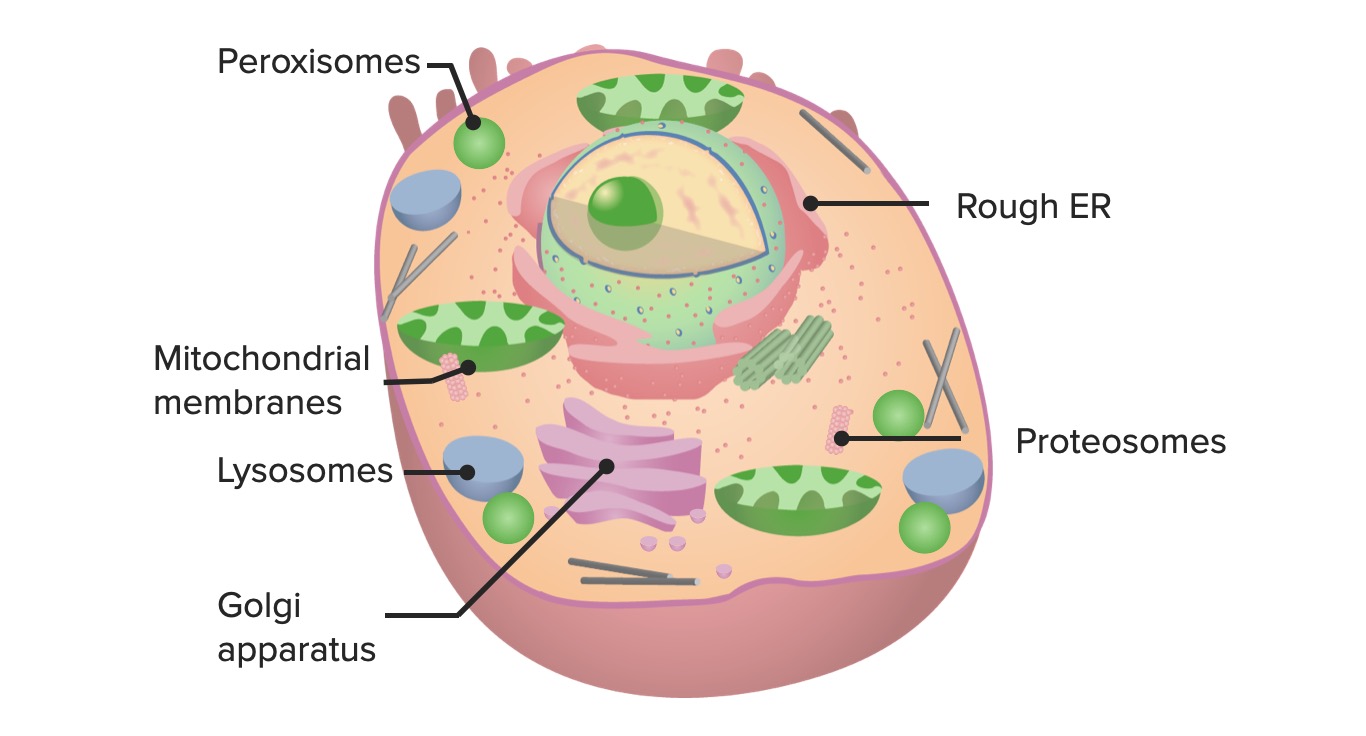Playlist
Show Playlist
Hide Playlist
Nucleus and Ribosomes
-
Slides 06 CellularStructure CellBiology.pdf
-
Reference List Molecular and Cell Biology.pdf
-
Download Lecture Overview
00:00 So the nucleus is certainly the brains, the operation of the cell. So the nucleus is a spherical structure. 00:10 It's bound in a double membrane. And it has nuclear pores. 00:14 It actually got pores all over it so that things can move in and out of the cell. 00:19 And we used to think things move pretty freely into and out of the cell. 00:23 However it turns out that the nucleus is pretty selective about what it lets in and out as the cell membrane is fairly selective about what it lets in and out. 00:35 Inside the nucleus, again we have the DNA, generally it is unwound in its chromatin form because the cell needs to access the DNA in order to produce proteins through transcription and translation in order to make proteins that support the cell's functions. 00:54 Must take a little bit closer look at the nuclear pores that we see in the cells. 01:00 Again, the nucleus is a double phospholipid bilayer. So two phospholipid bilayers with a little bit of space in between. 01:12 There is a protein pore going through the cell as we've looked at in previous lectures. 01:18 These proteins, this is one of where the protein has function allows a channel for things to move through. 01:25 Recently we've learned that that protein pore has a little bit more detail in selectivity. 01:33 We know that on the internal surface we have this nuclear basket and that basket is going to control how things move in and out through the pore It's not quite clear yet how it does this, but we do know that it's involved in this. 01:49 And on the outside of the nucleus, on the outer membrane, we see that there are some fibers that perhaps even sweep things in towards that nuclear pore. 02:02 So these pores are much more selective than we had previously thought. 02:08 So now, we understand these nuclear pores and that we have a nucleoid region inside of the nucleus where we'll see that much of the RNAs produced to compose ribosomes. I think it's time for us to take a look at the ribosome itself. 02:26 Ribosomes can either be free floating around in the cell or they can be bound to the endoplasmic reticulum. 02:32 Ribosomes are the protein making factories of the cells. They are composed of two subunits. 02:39 Again, the subunits are built primarily of RNA and a little bit of protein. 02:46 And they're often assembled in the nucleoid region of the nucleus. So we have a large subunit, and we have a small subunit. 02:54 And they stay apart actually until it's time for them to take a DNA message on messenger RNA and actually manufacture a protein. 03:05 So large subunit and small subunit could be floating around in the cytoplasm. 03:09 And if it's time to make a protein, if there's messenger RNA floating around, then they'll assemble on that messenger RNA and start translating that code into a protein in order to either make the protein to stay or to go.
About the Lecture
The lecture Nucleus and Ribosomes by Georgina Cornwall, PhD is from the course Cellular Structure.
Included Quiz Questions
Which of the following statements regarding the nucleus is correct?
- It is surrounded by a double-layered phospholipid bilayer studded with protein channels.
- Nuclear pores let materials flow freely in and out of the nucleus.
- Its main function is energy production.
- It is surrounded by a single phospholipid layer studded with ribosomes.
- The nuclear basket is fixed to the outer surface of the nucleus.
Which of the following is TRUE regarding the structure and function of a nuclear pore?
- A protein channel with a nuclear basket on its inner surface and cytoplasmic filaments on its outer surface that is responsible for highly selective transport into and out of the nucleus
- A protein channel with a nuclear basket on its inner surface and cytoplasmic filaments on its outer surface that allows nonselective transport out of the nucleus
- A protein channel with cytoplasmic filaments on its inner surface and a nuclear basket on its outer surface that is responsible for highly selective transport into and out of the nucleus
- A protein channel with a nuclear basket on its inner surface and cytoplasmic filaments on its outer surface that allows nonselective transport into and out of the nucleus
- A protein channel with a nuclear basket on its inner surface and cytoplasmic filaments on its outer surface that allows nonselective transport into the nucleus
Which of the following statements is FALSE regarding ribosomes?
- Ribosomes help in the synthesis of mRNA inside the nucleus.
- Ribosomes are found free-floating in the cytoplasm or attached to the endoplasmic reticulum.
- A complete ribosome is composed of two subunits, namely, a smaller subunit and a larger subunit.
- Ribosomes have the unique feature of decoding information present on mRNA.
- Owing to their protein-synthesizing capabilities, ribosomes are known as protein-making factories of cells.
Customer reviews
5,0 of 5 stars
| 5 Stars |
|
1 |
| 4 Stars |
|
0 |
| 3 Stars |
|
0 |
| 2 Stars |
|
0 |
| 1 Star |
|
0 |
Great material easy to learn good pictures …..thank you so much




